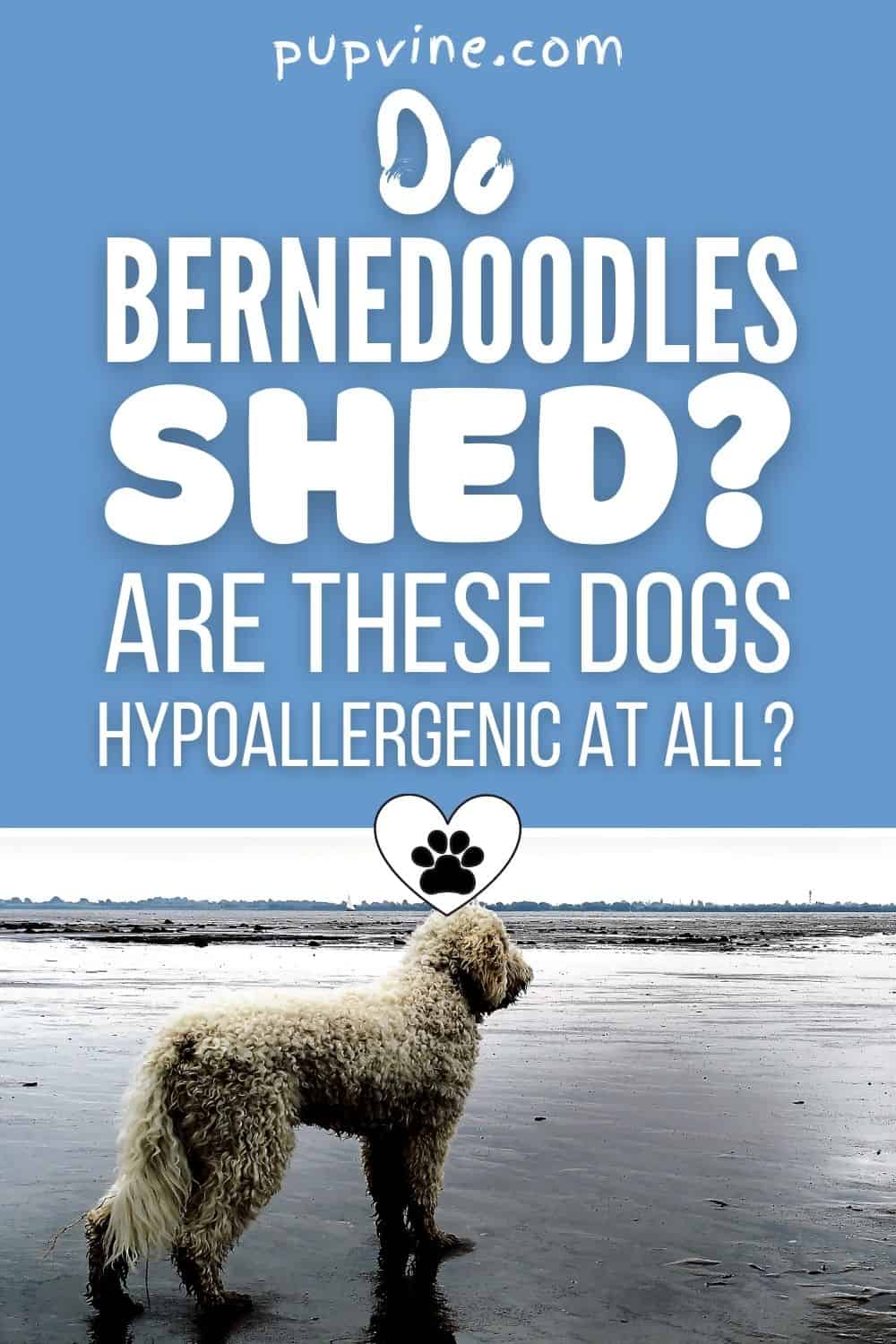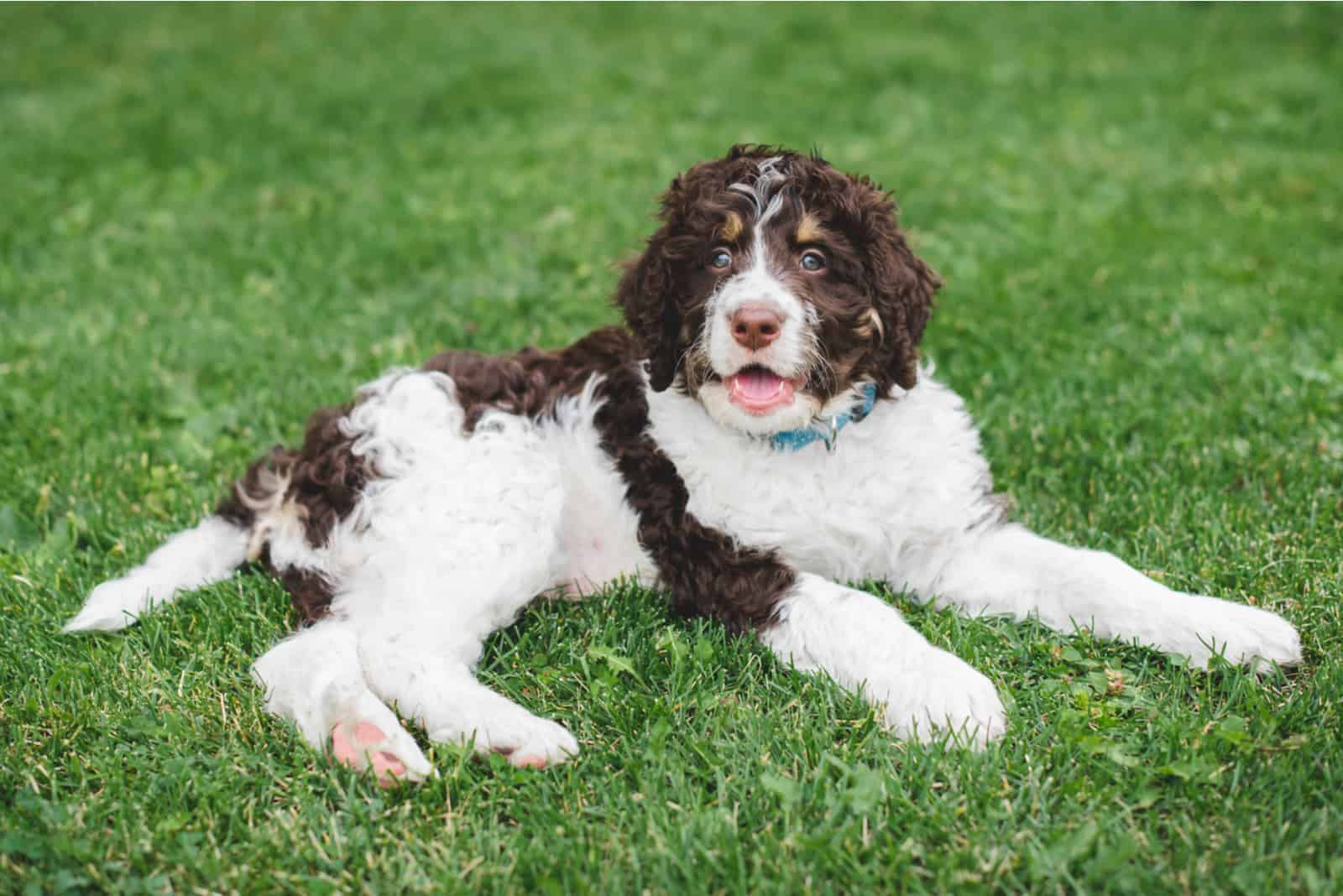Doodles are, without a doubt, the most famous type of crossbreeds. Everyone seems to love these adorable Poodle mixes!
Labradoodles and Goldendoodles are pretty standard, and almost everything has been said about them. Bernedoodles are slowly reaching that level of popularity, but many things about them are still unknown to the general public, such as:
Do Bernedoodles shed, or are they hypoallergenic like any other Doodles?
The main reason why Doodles are so popular is that they are a perfect mix of adorableness and safety. Yes, many Doodles are perfectly safe for allergy sufferers! And who wouldn’t love to have a Labrador Retriever who doesn’t worsen their allergies?
But maybe you’d like to steer away a bit from the standard and to get a crossbreed that isn’t as popular – such as a Bernedoodle.
So, do Bernedoodles shed?
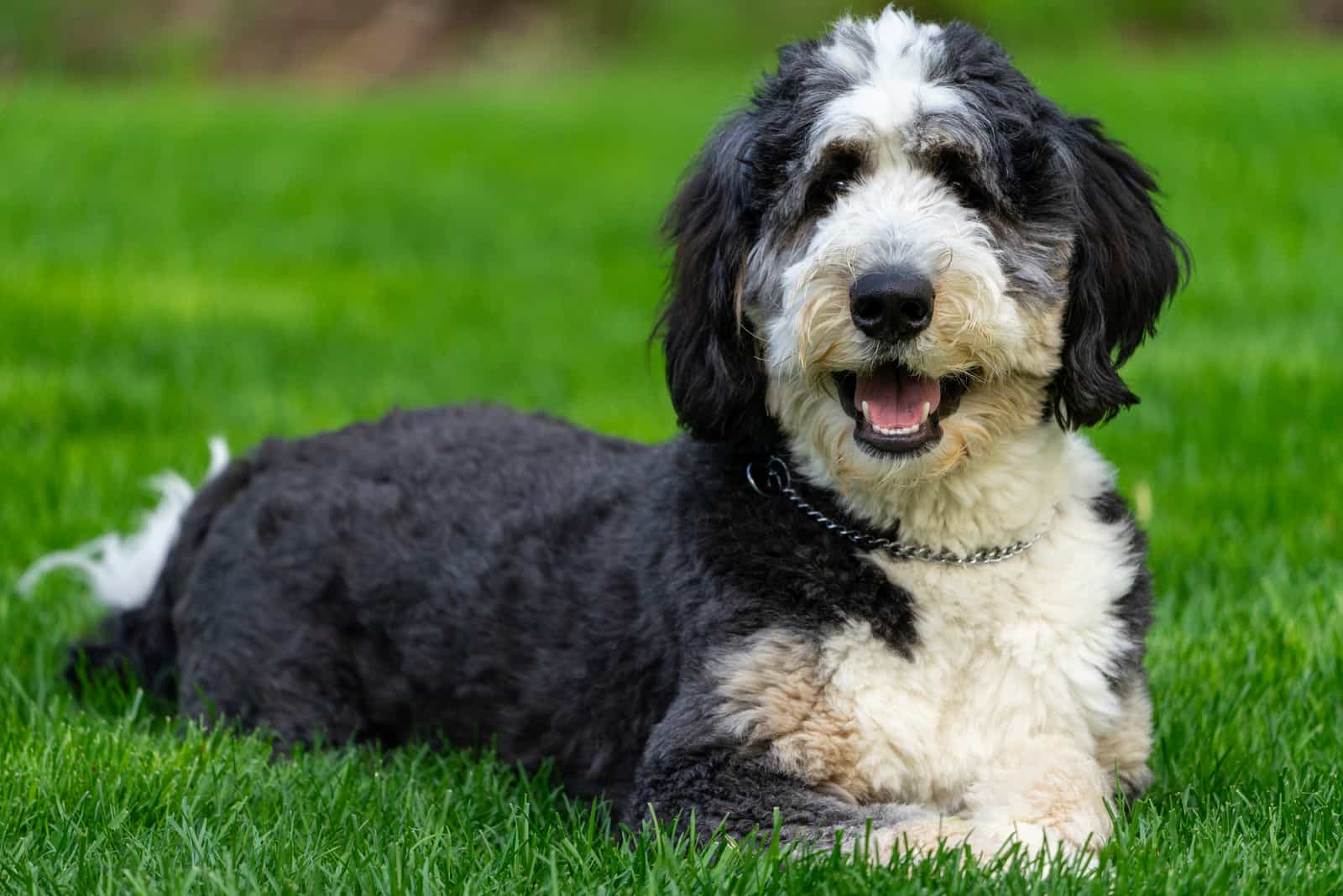
I’ll give you the answer – and I’ll also include some useful information on how you can reduce the shedding and share tips on Bernedoodle grooming and brushing.
Let’s begin!
Do Bernedoodles Shed?
To begin by answering your burning question: Bernedoodles don’t shed that much.
However, this is nothing but a simplified answer, as the topic goes much deeper than that one sentence.
Most Bernedoodles won’t experience high amounts of shedding. Some might even be entirely non-shedding! Others, however, might even experience high shedding amounts.
Many factors affect the amount of shedding your Bernedoodle might experience. This includes factors such as the parent breeds (or, rather, the type of the Bernese Mountain Dog in question), the inherited coat type, but also the generation of Bernedoodles you have.
As such, it’s impossible to give you a precise answer that can be used for all Bernedoodle dogs.
Bernedoodle Coat Type
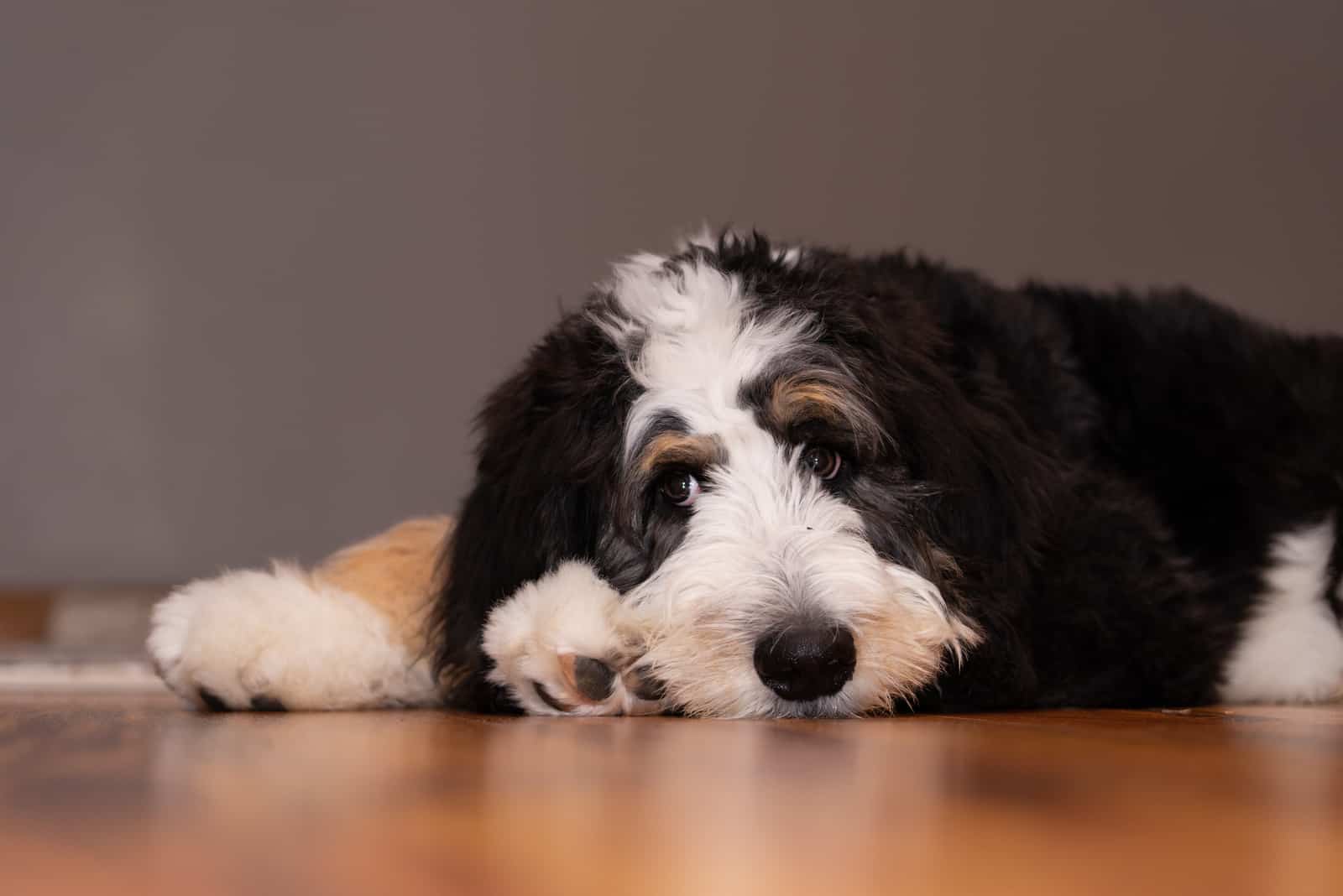
The first and the most important factor is the coat type your Bernedoodle has.
A Bernedoodle is a mixed breed dog with a purebred Poodle parent and a purebred Bernese Mountain Dog parent.
Mixed breeds tend to inherit traits from both parents, but this doesn’t have to be a 50 – 50 distribution. I’ll explain.
A Poodle has a coarse, curly coat. Curly coats are generally non-shedding, as the loose hairs don’t fall off, but rather get tangled with the rest of the coat, and they stay there until you brush them.
A Bernese Mountain Dog, on the other hand, has a double coat with a thick undercoat and a longer, straight topcoat. This type of coat is known for shedding, and the same can be said for the Bernese Mountain Dog.
Berneses’ shed in moderate amounts all year long, but this shedding amount will increase twice a year when it’s shedding season.
As such, Bernedoodle puppies can have three coat types:
• A curly coat, like a Poodle. This type of coat is non-shedding.
• A wavy coat, which is between the coat of two parent breeds. Such coats can shed, but the amount of shedding won’t be large and it’s usually effortless to manage.
• A straight coat that they inherit from a Bernese Mountain Dog. This type of coat will shed.
Shedding and Bernedoodle Generations
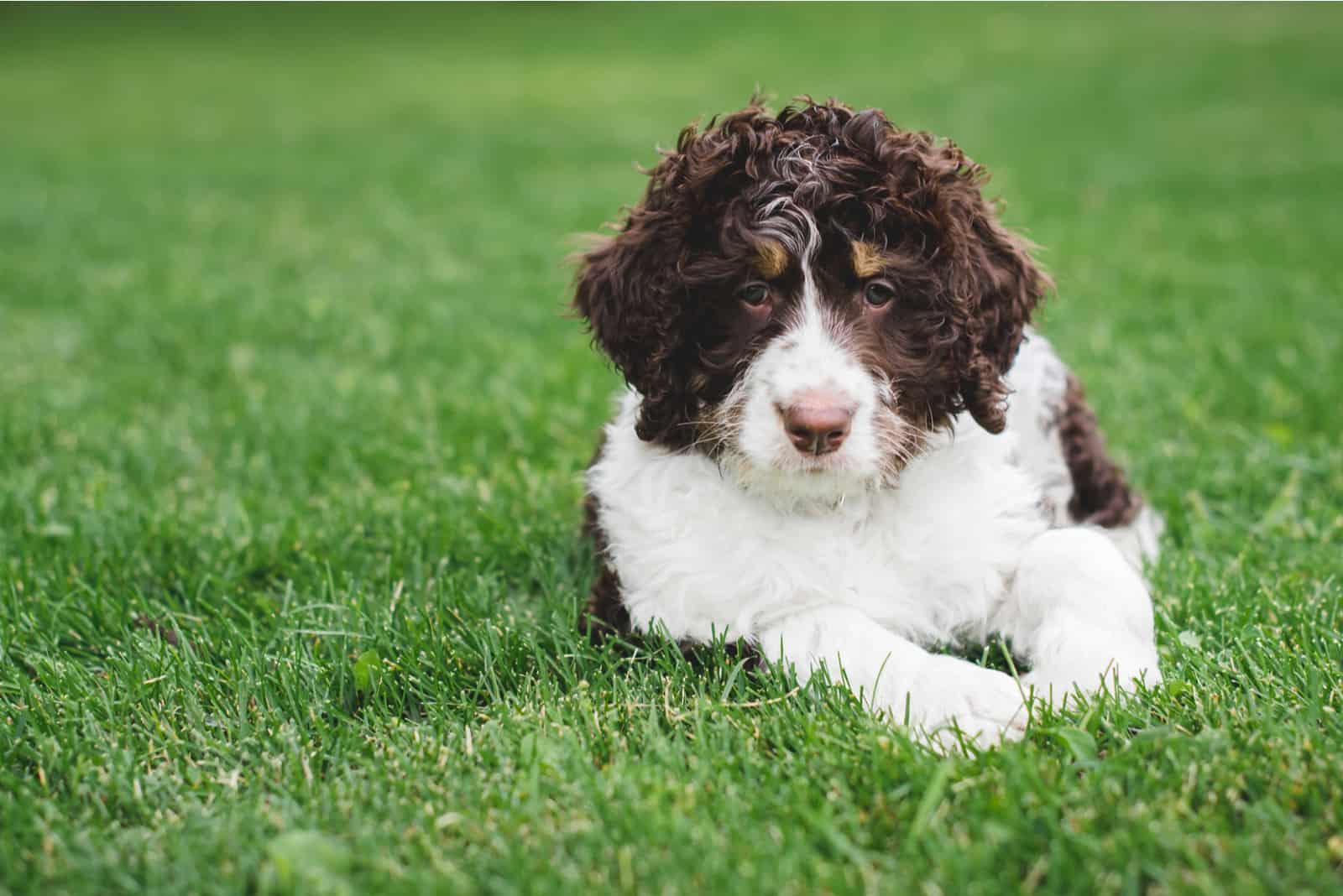
Not all Bernedoodle generations will shed the same amount. Some generations, such as F1 or F2, are impossible to predict. Others, such as F1B Bernedoodles, are much more stable.
This is what I mean:
• F1 Bernedoodles are the first generation of Doodles, which means they are 50% Poodles and 50% Bernese Mountain Dogs. As such, they have an equal amount of chances to be both non-shedding and shedding a lot. It all comes down to the Poodle genes the puppy inherits.
• F2 Bernedoodles, just like F1 dogs, are also 50 – 50. However, their traits are challenging to predict, some even an F2 Bernedoodle with two non-shedding parents might end up shedding.
• F3 Bernedoodles, or multi-generation Bernedoodles, while still having 50% Poodle and 50% Bernese Mountain Dog genes, are more stable than F2 Bernedoodles, and the later the generation, the more likely you’ll be to predict the outcome – most of the time. Exceptions always exist.
• F1B Bernedoodles – These dogs are usually 25% Bernese Mountain Dogs and 75% Poodles. As such, they will usually have many traits of their Poodle parent, meaning they are likely to be low-shedding or non-shedding.
• F1BB Bernedoodles are 87.5% Poodles and only 12.5% Bernese Mountain Dogs, which means they are more than likely to be non-shedding.
https://www.youtube.com/watch?v=EN0a2vJ9Ggs
• F2B Bernedoodles will have 37.5% Bernese Mountain Dog genes, and 62.5% Poodle genes. This means they’re less likely to shed than F1 or F2 Poodles, but more likely to shed than F1B or F1BB Bernedoodles.
• F2BB Bernedoodles are 81.25% Poodles and 18.75% Bernese Mountain Dogs. This means they have a high chance of being hypoallergenic, but they are more likely to shed than F1BB Bernedoodles.
In the end, as you can see, it all comes down to how many Poodle characteristics has the Bernedoodle puppy inherited.
The more Poodle traits your pooch has, the less likely he is to shed.
Do Parent Breeds Matter?
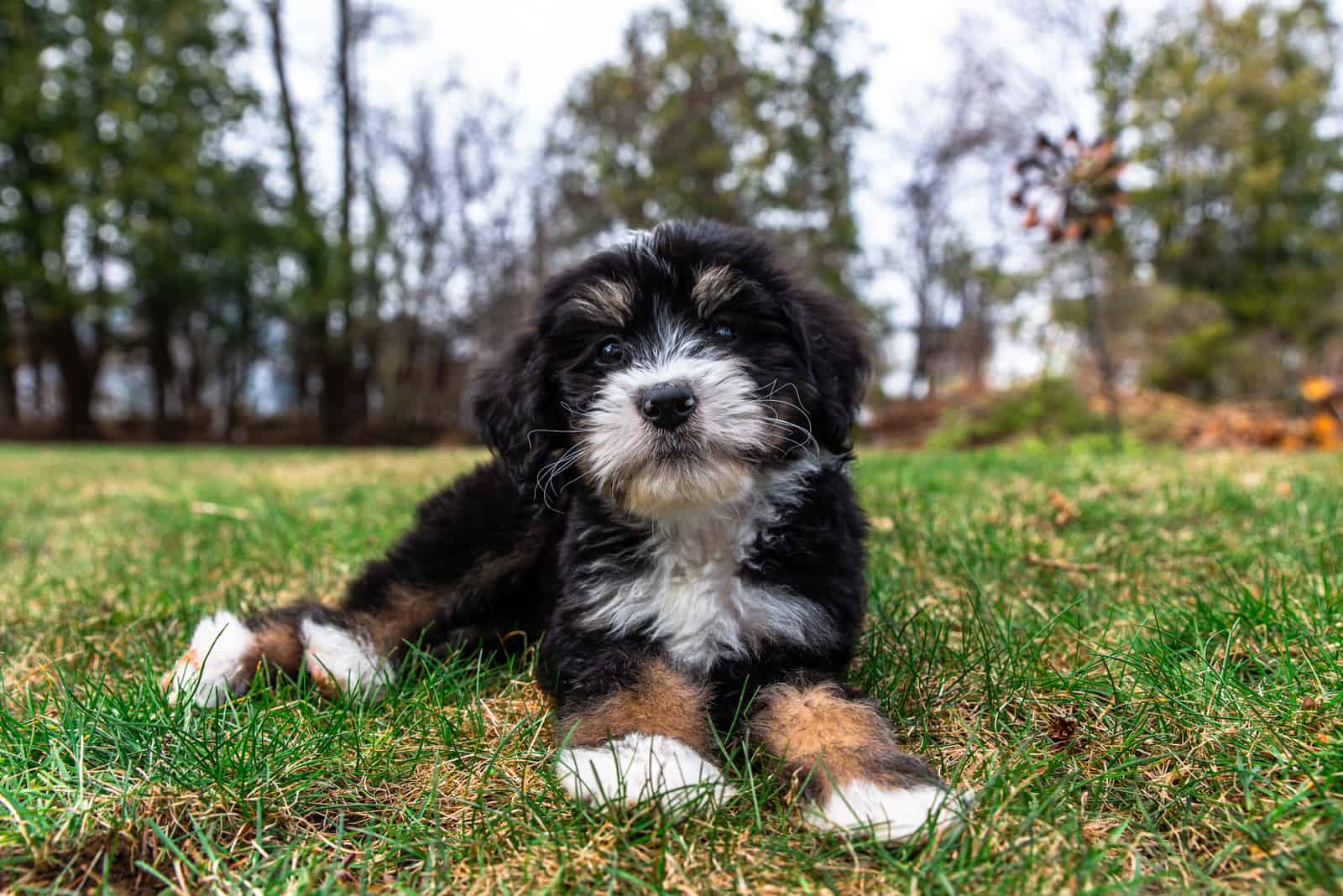
Parent breeds play a major role when it comes to whether Bernedoodles will shed or not. No matter if we’re speaking about F2 dogs that have two crossbred parents, or F1 pups with two parents of a different breed, the parent’s genes determine what a dog will look like.
For example, you have Australian Bernedoodles, dogs that are a crossbreed of the Australian Labradoodle and a Bernese Mountain Dog.
While these pups are called Bernedoodles, their shedding amount will greatly vary, as their parents are different.
Similarly, some Bernese Mountain dogs might have a bit shorter coat, which means their offspring has a greater chance of being low-shedding.
Also, the size of the Poodle matters. If the parent is a toy Poodle, the Bernedoodle might be of smaller size, which also means less shedding.
Other Factors That Affect The Amount Of Shedding
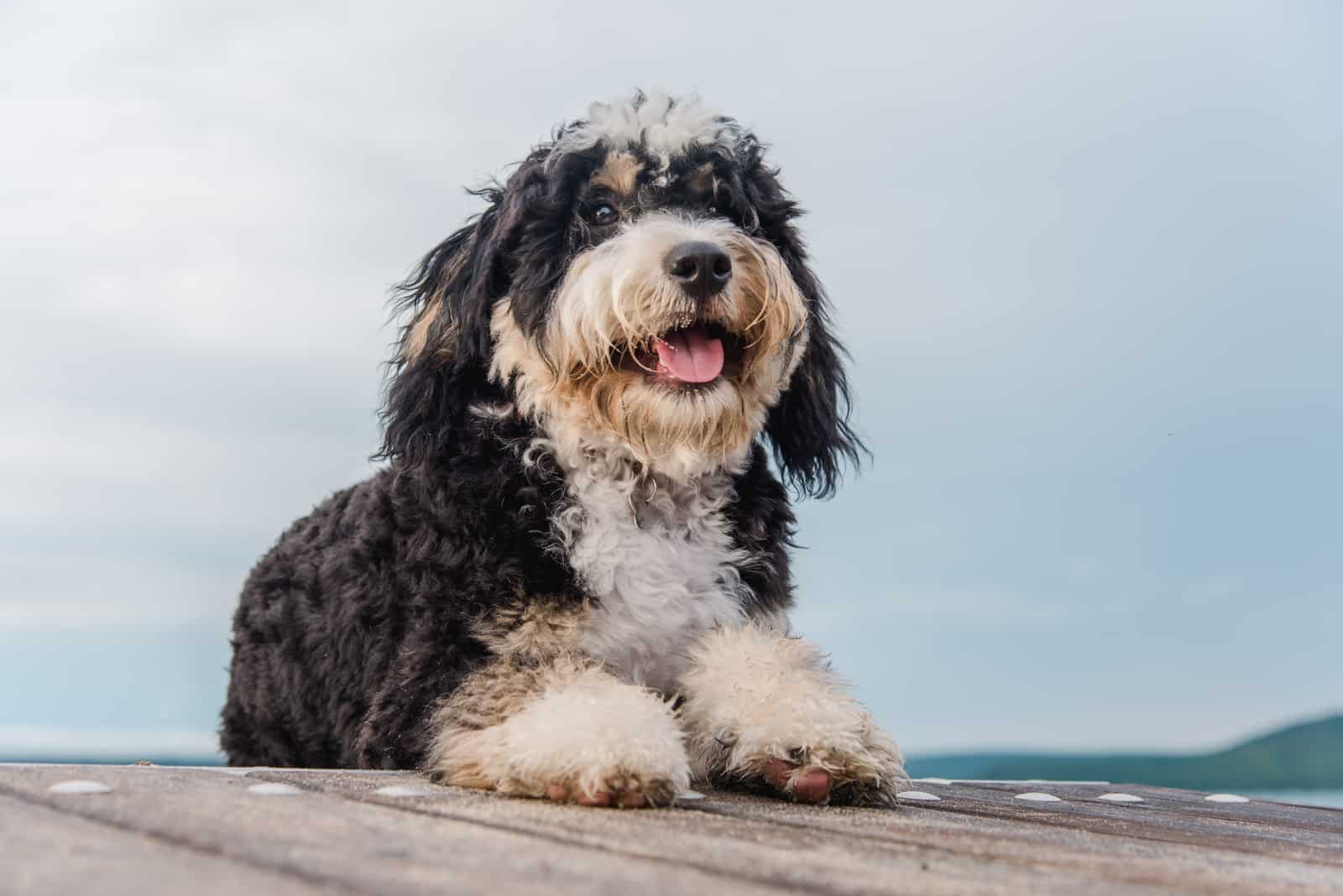
There are a few other factors that might affect the amount of shedding your Bernedoodle has. These are usually down to individual traits some dogs possess.
For example, your pooch might have some skin allergies. This isn’t rare of many dog breeds, and Doodles are no different.
Another factor that can greatly influence the shedding amount is the Bernedoodle size.
The larger the dog, the more hair he has, which has a greater potential for shedding. For example, a mini Bernedoodle sheds less than a medium or a standard Bernedoodle. Stress is another contributing factor, and the dog that is stressed will usually express greater shedding amounts. This can happen if you’ve just brought your new puppy home, and they are needing some time to adjust.
The age of the dog also plays an important role. Puppies don’t have the same coat type as adult dogs. This puppy coat is known to shed more than the coat the dog will have as an adult. Finally, seasons can also affect how much your dog sheds.
All dogs with an undercoat, which includes Bernese Mountain Dogs and some Bernedoodles, will experience a greater amount of shedding in spring and autumn than throughout the year.
Even dogs with a single coat might still shed a bit more during the shedding season, even though this won’t be as noticeable.
In nature, all dogs must prepare themselves for winter and colder seasons, and then they need to shed this coat so they aren’t too hot during the summer. This is why it’s normal for all dogs to shed a bit more at a certain time a year.
So, How Much Do Bernedoodles Shed?
<img class=”>
So, after reading all of this, how much do Bernedoodles shed, really?
There are many factors that affect the amount of Bernedoodle shedding. As such, it’s challenging to predict or say with certainty how much do Bernedoodles shed.
However, most Bernedoodles will be low shedding dogs, even though some might experience a higher shedding amount if they look too much like their Bernese parents.
Bernedoodle shedding is very individual, and it might depend on your dog’s coat type, and also his health.
When To Worry?
There are certain health issues that might increase the amount of Bernedoodle shedding. In fact, any sudden change in the shedding amount might indicate that there are some health problems present.
However, this doesn’t mean you should panic the moment you notice your doggie is shedding. Still, there are some occasions where it might be smart to rush to your vet.
For example, if you notice any bald spots on your Bernedoodle, this is a huge red flag. Such a huge hair loss is usually a sign of some health problem, whether mild or severe.
Some of the health conditions that might lead to hair loss include:
• Nutrient deficiency.
• Skin infections.
• Insect bites.
• Demodectic mange.
• Autoimmune disorders.
• Endocrine diseases.
• Cancer.
• Alopecia.
If you notice your dog’s shedding amount has suddenly changed, or that he has experienced severe hair loss and bald spots, you should contact your vet as soon as possible.
This is especially the case if the hair loss is followed by some other symptoms, such as lethargy or vomiting and diarrhea.
Are Bernedoodles Hypoallergenic?
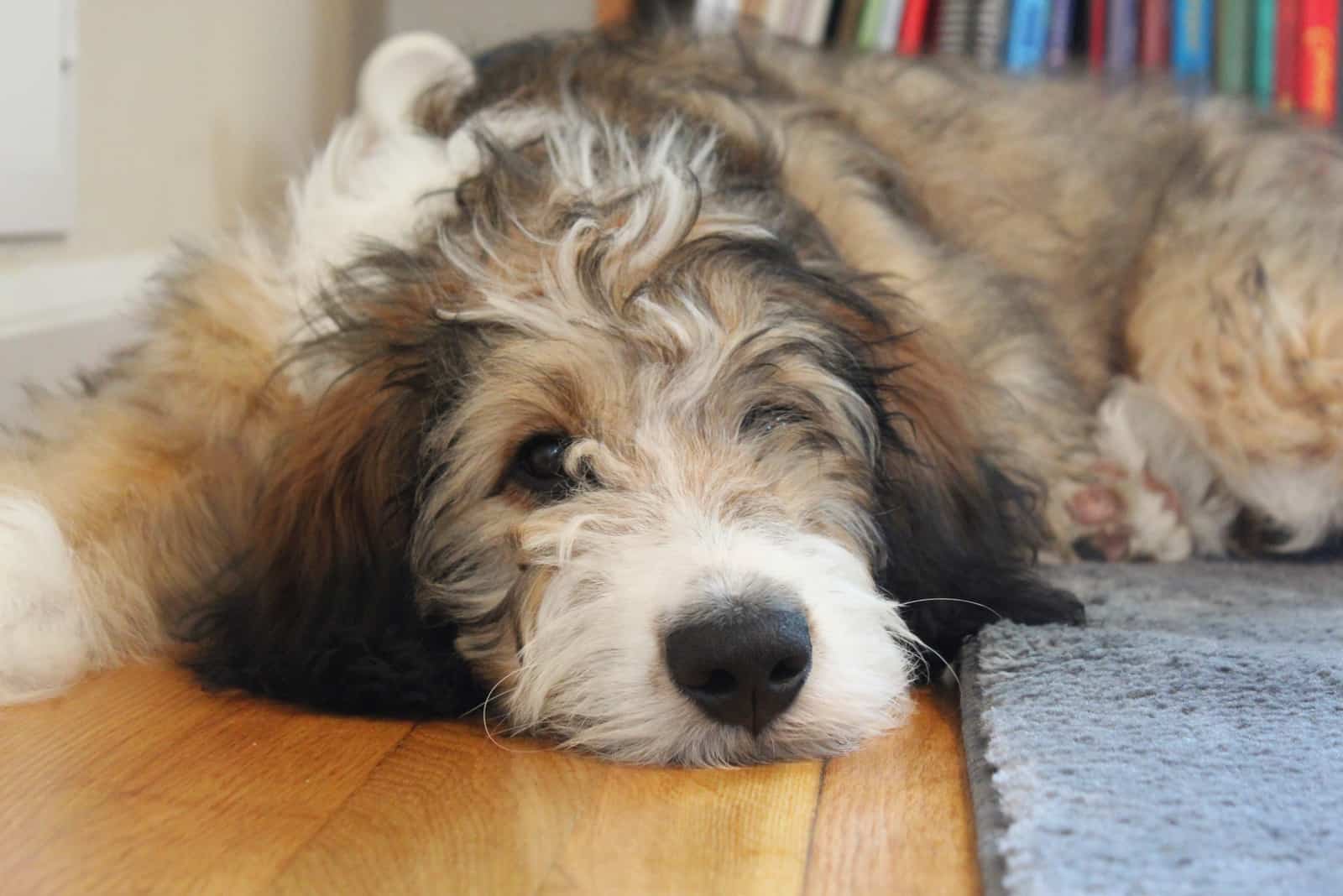
The main reason why people want to get Doodles is that they are hypoallergenic and safe for allergy sufferers. But is this really the case?
First off, you need to understand whether there are such things as hypoallergenic dogs and what does this term even mean.
Hypoallergenic is a term that means that something, whether that be an item or a pet, is free of allergens. This means that there are no ingredients or substances that might cause an allergic reaction in sensitive populations.
In dogs, however, things get a bit complicated.
Most people feel itchy or get an urge to sneeze when they breathe in dog hair. This makes them believe that it’s dog hair that’s giving them problems.
The truth is that it isn’t the dog’s hair that’s giving you problems – at least not directly. I’ll explain.
The main allergen in dogs is a specific type of protein found in the dog’s dander, urine, and saliva.
All dogs produce dander (dead skin cells), and this is the main culprit behind dog allergies. Dander will get stuck to the dog’s hairs, and this is how it’ll fly everywhere, including into your nose.
This is why dogs that experience high shedding amounts will cause more severe allergic reactions compared to dogs that don’t shed. Dog’s hair is contaminated with dander, causing problems allergy sufferers face.
All dogs drool and urinate, as well. These liquids can get onto the dog’s hair, finding their way on your clothes, floor, and furniture.
As the result, you will feel as if the dog’s hair is causing you problems, while it is only the protein that got caught onto the hair.
As all dogs produce these substances, it’s easy to conclude that no dog can truly be considered hypoallergenic. All of them can cause you issues if you get in contact with this protein.
However, when you have a dog that doesn’t shed, the dander doesn’t get off of the dog’s body or even to the top layers of his coat, so it won’t easily bother you.
Not just that, but many dogs are very clean and won’t easily get urine on themselves. Some also don’t drool that much.
While Bernese Mountain Dogs are prone to shedding and they tend to drool, Poodles are some of the cleanest dogs you can find. They don’t shed, don’t drool, and they’ll be very mindful of their toilet habits.
As such, Bernedoodles with lots of Poodle features can be considered safe for allergy sufferers – although they might still cause problems in people with the most severe forms of dog allergies.
This doesn’t mean that these dogs will never cause you issues, but if they do, the problems will usually be effortless to manage.
Once again, it’s essential to note that not all Bernedoodles are the same. While some won’t shed at all, others might experience a significant amount of shedding.
As such, it’s very important to be careful when picking the right dog for you and to work with a Bernedoodle breeder who knows how to help you pick the right dog for you.
Also, you might want to consider the size of your Bernedoodle. A Miniature Bernedoodle will shed less than a Bernedoodle of a larger size.
Tips on Reducing Shedding
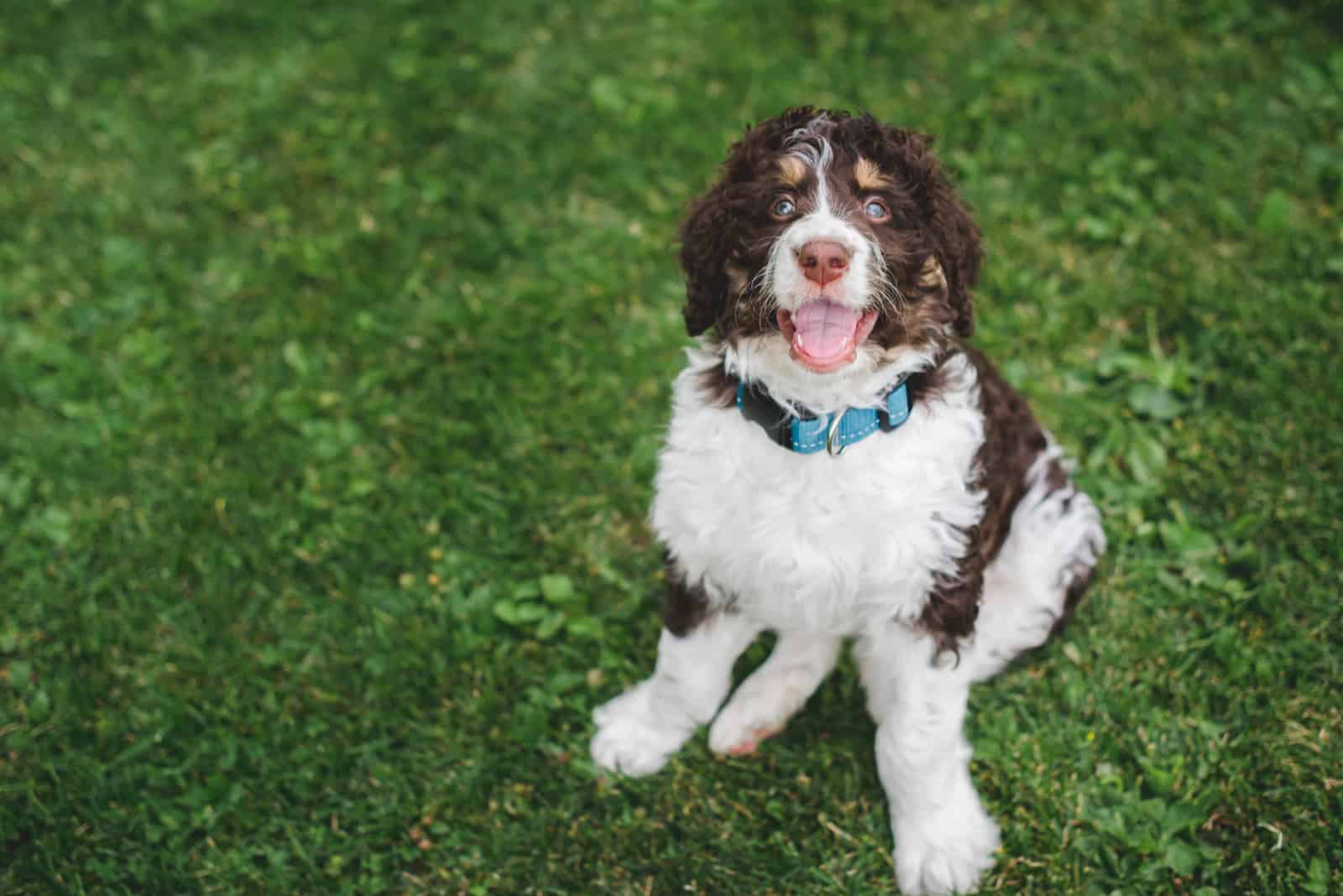
If you happen to have a Bernedoodle that does shed, don’t worry. There are some things you can do to try to get the shedding amount under control and to help yourself feel better, even if you’re having allergy problems.
Even allergy-friendly Bernedoodles might cause problems for some dog owners, so you need to be very mindful about how you’re dealing with shedding.
Fortunately, if you do just a few things right, you’ll manage to minimize the shedding amount and to ensure your house is squeaky clean.
Here are a few things you can do to manage your Bernedoodle shedding:
Regular Brushing
The best thing you can do to manage your Bernedoodle shedding is to brush your pooch regularly.
When you brush your dog, you do more than prevent matting and tangling. By brushing, you’re collecting loose hairs from your pup before they manage to fly away and contaminate your environment.
Not just that, but by using the best hairbrush for Doodles, you’ll also redistribute natural oils throughout the dog’s skin and coat, ensuring they are properly hydrated. A good choice is a slicker brush or a bristle brush, but you might experiment.
When the dog’s skin and coat are healthy, it’s less likely to shed. This is why regular grooming and brushing is the best possible thing you can do for your dog.
Proper Bathing
Bathing is another great thing you can do to ensure your dog’s wellbeing. However, many Bernedoodle owners make a few mistakes.
First and foremost, while bathing is important, many people tend to go overboard. You shouldn’t brush your dog too often, as this can do more damage than good.
If you bathe your dog too often, you’ll dry out his skin. This will increase the shedding amount, while also worsening the dander production.
Not just that, but you also need to use high-quality dog shampoo. Don’t ever use human shampoos for your pooch.
Dogs and humans don’t have the same type of skin. Look at your dog. He has a thick layer of coat to protect it, which is why canine skin is more sensitive compared to ours.
As such, our shampoos can cause significant damage to the dog’s coat. This is why you need to use shampoos meant for dogs only.
Proper Diet
The next best thing you can do for your Bernedoodle is to ensure you feed him with the best dog food possible.
Proper nutrition can ensure your dog is healthy and happy. This will be noticeable on his coat and skin, as well.
A dog that eats well will also have a healthy, shiny coat. Similarly, if a dog doesn’t eat proper food, his coat will suffer.
If you notice your pooch’s shedding amount is increasing and he is entirely healthy, try changing his diet. Chances are he is lacking in some nutrients.
Fortunately, there are many good dog foods you can find on Amazon and other similar websites.
Not just that, but your Bernedoodle might have some food allergy. While they are not too prone to allergies, this might happen with any breed.
If you’ve recently changed your dog’s diet, chances are there is something in his food that is causing him problems that are resulting in hair loss.
Supplements
Next to feeding him proper dog food, you might also give him certain supplements.
The best option is to find fatty acids supplements, such as omega-3 and omega-6 amino acids. These are an amazing option if you’d like to add some shine and health to your dog’s haircoat.
Allergy Medicine
If your dog happens to struggle with dog allergies, you can ask your event about some medicine for allergies that can help ease his symptoms.
Just like there are antihistamines for people, there are certain medications that can help dogs get relief from allergies.
When you give these medications to your pooch, they can help reduce their allergy symptoms, which include dry skin. This means reducing dog shedding and symptoms of your allergies.
Regular Vacuuming
If your Bernedoodle is shedding no matter what you do, the next thing you should do is to clean the dog hair that flew everywhere.
If you’re having issues with dog allergies and the brushing doesn’t work, the next best thing is to regularly vacuum your house and every room your dog is in.
Vacuuming is the only way to entirely clean the dog hair from your house. As such, it might be best if you’d vacuum your home daily.
Upholstery Covers
Not even vacuuming can ensure that all dog hairs are cleaned, especially not from upholstery and clothes.
As such, the best option is prevention. You can choose some upholstery covers that not only look nice but will save your furniture from dog hair. And they’re easy to clean, at the same time! All you need to do is remove them and put them in a washing machine.
Upholstery covers are a great way to ensure there are no hairs everywhere, which is a great way to prevent allergies and reduce the number of loose hairs around.
Bernedoodle Grooming Tips
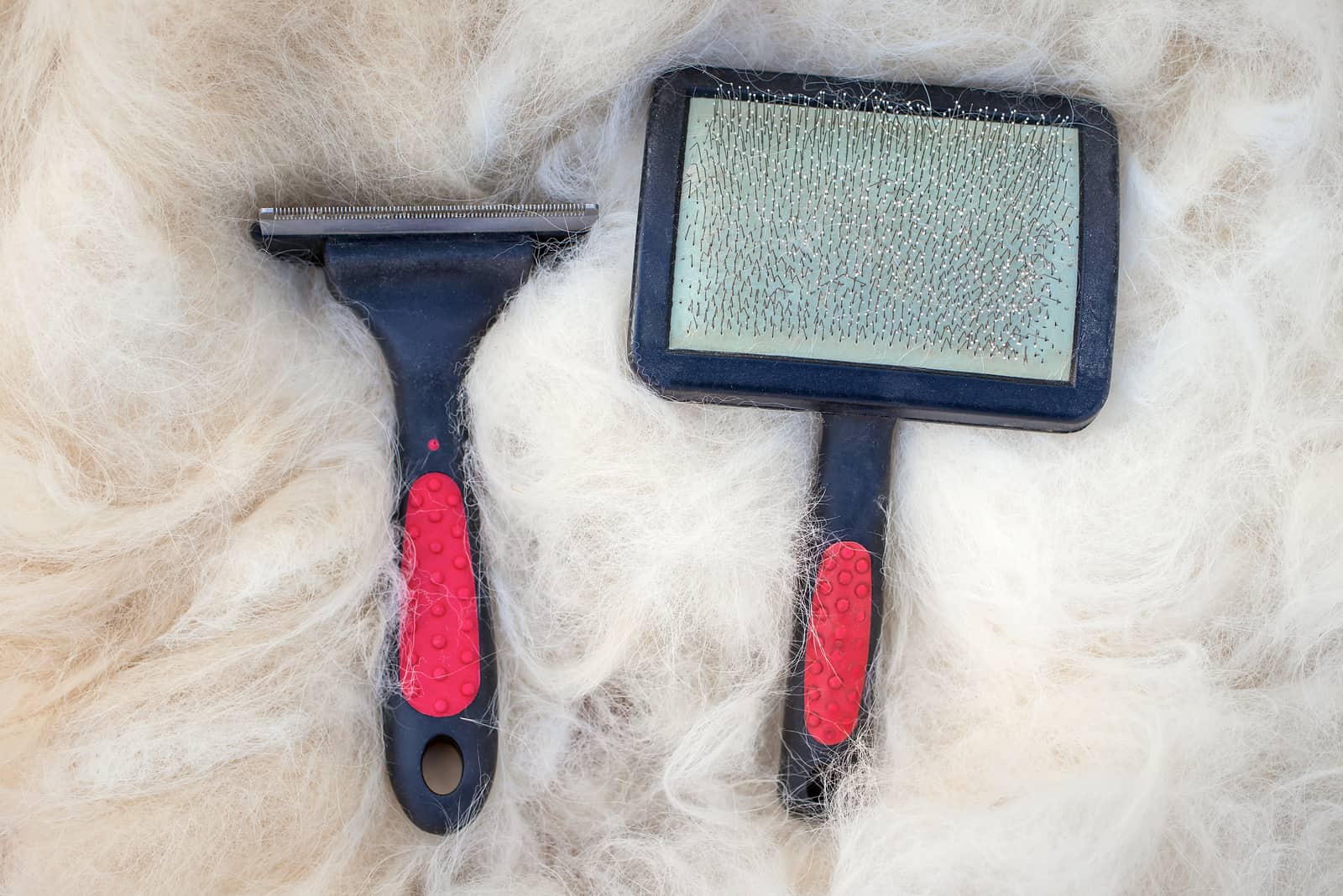
When you have a Bernedoodle, you probably want to ensure it looks as cute as possible – while also keeping his coat healthy and shiny.
Fortunately, Bernedoodles don’t need plenty of grooming – and even if you take them to a professional groomer, they don’t need lots of attention. Curly coat Bernedoodles can be as easy to handle as a Standard Poodle – which is a fairly easy dog to deal with.
In general, crossbreeds have similar grooming needs as purebred dogs of the same coat type. As such, most groomers will know how to deal with them.
If you’d like to deal with them on your own, here are a few things you need to know:
• I’ve already mentioned this, but I need to stress this again: You need to brush your dog every day, or at least every two days. This is the best option to ensure his coat is healthy.
• If your Bernedoodle has a straight coat, it’ll shed more, but it’ll be easy to brush. Such a dog doesn’t require any specialized brush, and it doesn’t need any special care, but daily brushing is a must.
• If the coat is wavy, you’ve hit a jackpot! Such a dog is effortless to manage. It requires occasional brushing, and it won’t shed a lot.
• Bernedoodles with curly coats are the best for people with dander allergies, but they are prone to matting, and they require daily brushing with brushes suitable for such coats. They are the most challenging to maintain.
Now that we’ve got this out of the way, here is how to properly groom your Bernedoodle:
Step 1: Inspecting
Before you start brushing your dog, you should pet your dog with your hand and brush them through their coat.
Feel your dog’s skin and coat and try to look for any bumps, lumps, and dry patches. If you notice any abnormalities, try to inspect them further and see if they are anything to worry about.
Also, look for any bald patches or excessive skin loss. If you notice anything worrisome, contact your vet immediately.
Step 2: Brushing
Now, you need to brush your Bernedoodle. This will depend on the coat type your dog has, as this will influence how much brushing your pooch needs and what’s the proper brush type.
Make sure the brush is gentle enough not to harm your dog or to scratch his skin.
Step 3: Bathing
I’ve talked a lot about bathing your dog, and why it’s important – but also why it’s important not to bathe your dog too much.
You might want to bathe your dog before brushing him, as this is a good way to detangle him and remove any harsh mats. This can make brushing much easier.
Step 4: Clean His Eyes
You should always check your Bernedoodle’s eyes to make sure there are no irritations or any type of discharge.
If you see any discharge, use grooming wipes or some gentle solution your vet prescribed to ensure his eyes are clean.
If anything is abnormal, you might want to visit your vet to make sure your pup doesn’t have any infections that need professional treatment.
Step 5: Check His Ears
Your Bernedoodle will need good ear cleaning from time to time, especially if he has floppy ears. This will help remove any dirt, but also wax buildup.
Look for any irritation. If your Bernedoodle has redness in his ears, chances are something is irritating him and you need to clean it or to give him some treatment.
This might also be a sign of allergies. Contact your vet to be sure what’s the issue.
Another red flag is if you notice your pooch is scratching his ears or constantly shaking his head. There is also a chance of bad odor happening.
Step 6: Don’t Forget Nail Clipping
Many dog owners forget nail clipping, something that is important for your dog’s wellbeing. If your Bernedoodle’s nails become ingrown, this can cause severe pain and discomfort. Not just that, but this can even cause walking problems.
Bernedoodle nail clipping isn’t an easy task, especially if your Bernedoodle isn’t used to such a task. You might want to take your pooch to a groomer or a vet if you cannot do this properly.
If you don’t clip your dog’s nails properly, you are risking hurting your dog or even causing open wounds, pain, and infections.
Step 7: Clean His Teeth
Finally, you mustn’t forget your dog’s teeth. Oral hygiene is essential, and this is something many owners don’t think about until it’s too late.
However, studies show that up to 80% of dogs older than two years have some type of gum disease. While this might sound benign, dental problems can lead to many dangerous health conditions, including even cancer.
As such, you should brush your dog’s teeth every three weeks. The moment you notice your dog has a bad breath, you need to take him to the vet.
Should You Get A Bernedoodle?
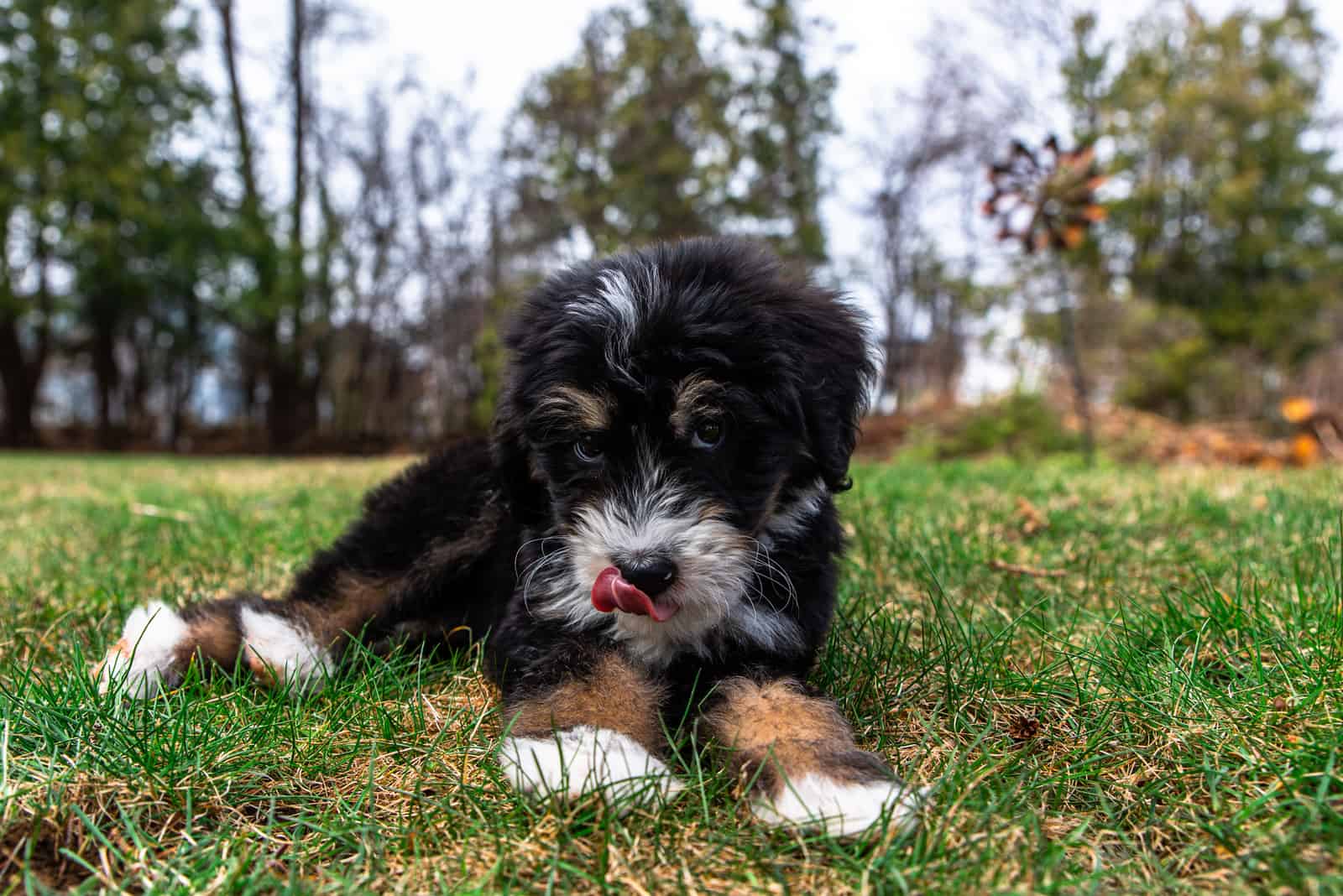
After reading all of this, is Bernedoodle the best dog for you?
This all depends on what you want and require from the dog, but also the type of Bernedoodle you have.
If you’re a person without dog allergies, all types of Bernedoodles are great family pets for you! These dogs are kind and gentle, and they are some of the best doggies you will find.
If you have dog allergies or don’t want to clean dog’s hair, things get a bit trickier.
You need to look for pups that have curly coats that don’t shed a lot. You might also want to look for specific generations, such as F1B Bernedoodles, that have more Poodle genes than Bernese Mountain Dog ones.
Look for breeders that know everything there is to know about mixed breed dogs. When you ask them “Do Bernedoodles shed?”, they’ll answer honestly that this will depend on the individual dog and that there are no guarantees.
As such, look for puppies that have the traits you need. Don’t necessarily look at the parent dogs, but specifically for dogs with the type of coat that is suitable for you.
If nothing else works, try to look for a way to reduce your allergy symptoms. Clean your house all the time, and keep your pooch outside of the bedroom.
You might also ask your doctor to give you antihistamines, or some other allergy that might help your allergy symptoms.
It’s important to keep in mind that just because a certain breed is giving you issues, this doesn’t have to mean that you’ll have a problem with all dogs. Don’t give up your dreams of becoming a dog owner just yet!
Read Next:
• Top 7 Reputable Bernedoodle Breeders In Florida
• 9 Bernedoodle Breeders In Texas: Lone Star State Doodles
• Top 8 Trustworthy Bernedoodle Breeders In Illinois
